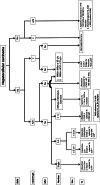Management Consensus Guidelines for Hepatocellular Carcinoma: 2023 Update on Surveillance, Diagnosis, Systemic Treatment, and Posttreatment Monitoring by the Taiwan Liver Cancer Association and the Gastroenterological Society of Taiwan
- PMID: 39435274
- PMCID: PMC11493393
- DOI: 10.1159/000537686
Management Consensus Guidelines for Hepatocellular Carcinoma: 2023 Update on Surveillance, Diagnosis, Systemic Treatment, and Posttreatment Monitoring by the Taiwan Liver Cancer Association and the Gastroenterological Society of Taiwan
Erratum in
-
Erratum.Liver Cancer. 2024 Apr 11;13(6):674. doi: 10.1159/000538572. eCollection 2024 Dec. Liver Cancer. 2024. PMID: 39780939 Free PMC article.
Abstract
Hepatocellular carcinoma (HCC) is the leading cause of cancer-related mortality in Taiwan. The Taiwan Liver Cancer Association and the Gastroenterological Society of Taiwan established HCC management consensus guidelines in 2016 and updated them in 2023. Current recommendations focus on addressing critical issues in HCC management, including surveillance, diagnosis, systemic treatment, and posttreatment monitoring. For surveillance and diagnosis, we updated the guidelines to include the role of protein induced by vitamin K absence or antagonist II (PIVKA-II) and gadoxetic acid (Gd-EOB-DTPA)-enhanced magnetic resonance imaging (MRI) in detecting HCCs. For systemic treatment, the updated guidelines summarize the multiple choices available for targeted therapy, immune checkpoint inhibitors, and a combination of both, especially for those carcinomas refractory to or unsuitable for transarterial chemoembolization. We have added a new section, posttreatment monitoring, that describes the important roles of PIVKA-II and EOB-MRI after HCC therapy, including surgery, locoregional therapy, and systemic treatment. Through this update of the management consensus guidelines, patients with HCC may benefit from optimal diagnosis, therapeutic modalities, and posttreatment monitoring.
Keywords: Diagnosis; Guideline; Hepatocellular carcinoma; Posttreatment monitoring; Surveillance; Systemic treatment.
© 2024 The Author(s). Published by S. Karger AG, Basel.
Conflict of interest statement
The authors have no conflicts of interest to declare.
Figures


References
-
- Sung H, Ferlay J, Siegel RL, Laversanne M, Soerjomataram I, Jemal A, et al. . Global cancer statistics 2020: GLOBOCAN estimates of incidence and mortality worldwide for 36 cancers in 185 countries. CA Cancer J Clin. 2021;71(3):209–49. - PubMed
-
- Health Promotion Administraion. Ministry of health and welfare . Taiwan: cancer registry annual report. 2020. Available from: https://www.hpa.gov.tw/Pages/List.aspx?nodeidZ269. (Accessed June 7, 2023).
-
- Surveillance group; Diagnosis group; Staging group; Surgery group; Local ablation group; TACE/TARE/HAI group, et al. . Management consensus guideline for hepatocellular carcinoma: 2016 updated by the Taiwan Liver Cancer Association and the Gastroenterological Society of Taiwan. J Formos Med Assoc. 2018;117(5):381–403. - PubMed
-
- European Association for the Study of the Liver Electronic address easloffice@easlofficeeu; European Association for the Study of the Liver . EASL clinical practice guidelines: management of hepatocellular carcinoma. J Hepatol. 2018;69(1):182–236. - PubMed
LinkOut - more resources
Full Text Sources

